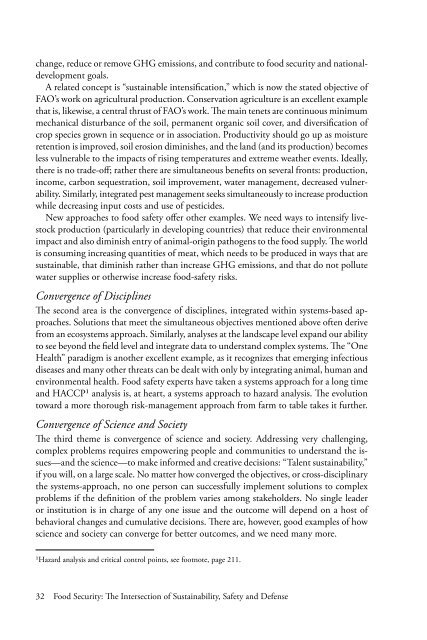Food Security - National Agricultural Biotechnology Council ...
Food Security - National Agricultural Biotechnology Council ...
Food Security - National Agricultural Biotechnology Council ...
- No tags were found...
You also want an ePaper? Increase the reach of your titles
YUMPU automatically turns print PDFs into web optimized ePapers that Google loves.
change, reduce or remove GHG emissions, and contribute to food security and nationaldevelopmentgoals.A related concept is “sustainable intensification,” which is now the stated objective ofFAO’s work on agricultural production. Conservation agriculture is an excellent examplethat is, likewise, a central thrust of FAO’s work. The main tenets are continuous minimummechanical disturbance of the soil, permanent organic soil cover, and diversification ofcrop species grown in sequence or in association. Productivity should go up as moistureretention is improved, soil erosion diminishes, and the land (and its production) becomesless vulnerable to the impacts of rising temperatures and extreme weather events. Ideally,there is no trade-off; rather there are simultaneous benefits on several fronts: production,income, carbon sequestration, soil improvement, water management, decreased vulnerability.Similarly, integrated pest management seeks simultaneously to increase productionwhile decreasing input costs and use of pesticides.New approaches to food safety offer other examples. We need ways to intensify livestockproduction (particularly in developing countries) that reduce their environmentalimpact and also diminish entry of animal-origin pathogens to the food supply. The worldis consuming increasing quantities of meat, which needs to be produced in ways that aresustainable, that diminish rather than increase GHG emissions, and that do not pollutewater supplies or otherwise increase food-safety risks.Convergence of DisciplinesThe second area is the convergence of disciplines, integrated within systems-based approaches.Solutions that meet the simultaneous objectives mentioned above often derivefrom an ecosystems approach. Similarly, analyses at the landscape level expand our abilityto see beyond the field level and integrate data to understand complex systems. The “OneHealth” paradigm is another excellent example, as it recognizes that emerging infectiousdiseases and many other threats can be dealt with only by integrating animal, human andenvironmental health. <strong>Food</strong> safety experts have taken a systems approach for a long timeand HACCP1 analysis is, at heart, a systems approach to hazard analysis. The evolutiontoward a more thorough risk-management approach from farm to table takes it further.Convergence of Science and SocietyThe third theme is convergence of science and society. Addressing very challenging,complex problems requires empowering people and communities to understand the issues—andthe science—to make informed and creative decisions: “Talent sustainability,”if you will, on a large scale. No matter how converged the objectives, or cross-disciplinarythe systems-approach, no one person can successfully implement solutions to complexproblems if the definition of the problem varies among stakeholders. No single leaderor institution is in charge of any one issue and the outcome will depend on a host ofbehavioral changes and cumulative decisions. There are, however, good examples of howscience and society can converge for better outcomes, and we need many more.1Hazard analysis and critical control points, see footnote, page 211.32 <strong>Food</strong> <strong>Security</strong>: The Intersection of Sustainability, Safety and Defense















